Cottage flower garden design brings a touch of charm and whimsy to any outdoor space. It’s all about creating a cozy and inviting atmosphere using a mix of colorful blooms and lush greenery. This style celebrates natural beauty, allowing flowers to blend harmoniously while encouraging delightful surprises around every corner. Perfect for garden enthusiasts and casual planners alike, a cottage garden promises to bring joy and tranquility to your home.
Designing Pathways with Natural Materials
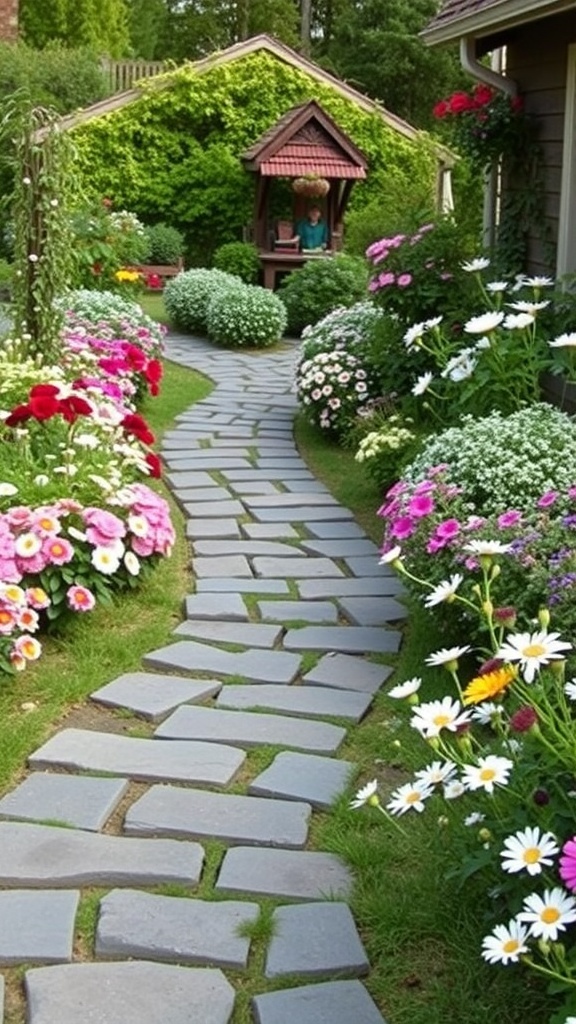
Creating pathways in a cottage flower garden can really bring the space to life. The image shows a charming stone path winding through vibrant blooms. This design invites you to stroll and enjoy the beauty around you.
Using natural materials like stone for pathways adds a rustic touch. The gray stones in the image complement the colorful flowers beautifully. They provide a sturdy surface while blending seamlessly with the garden.
When planning your path, think about the shape. A gentle curve, like the one shown, can make the garden feel more inviting. It encourages exploration and makes each step feel like a new discovery.
Consider the flowers you want to plant along the path. Bright colors and varied heights create visual interest. The mix of daisies, petunias, and other blooms in the image adds a cheerful vibe, making the walk enjoyable.
Finally, don’t forget about maintenance. A well-placed stone path can help control weeds and keep the garden tidy. Plus, it’s easy to clean and durable, ensuring your garden looks great season after season.
Selecting the Best Flower Varieties for Cottage Gardens
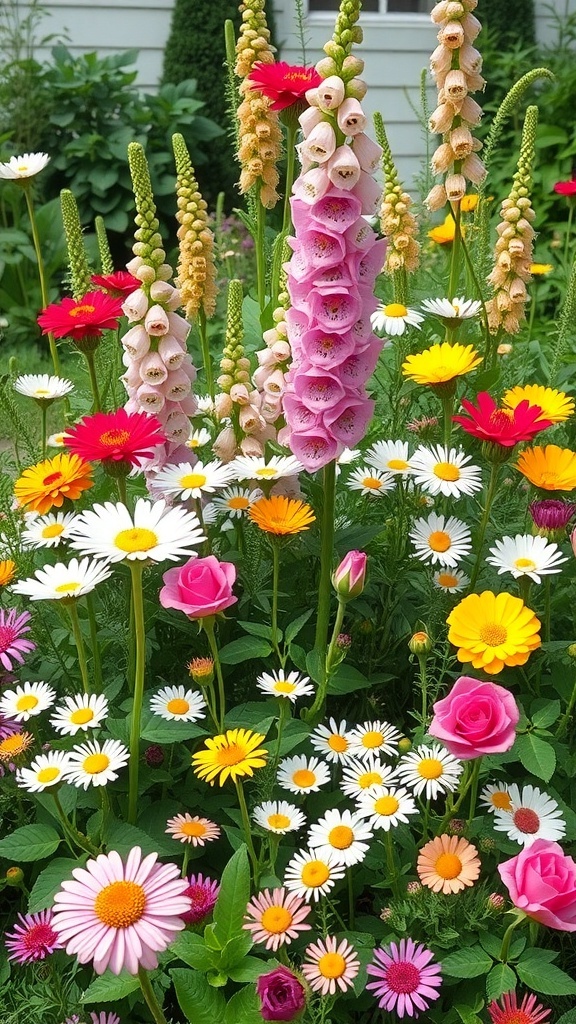
Cottage gardens are known for their charm and vibrant colors. When choosing flowers, think about mixing different types to create a lively display. The image shows a beautiful array of flowers, including daisies, roses, and foxgloves. Each variety adds its own unique flair.
Start with classic choices like daisies and sunflowers. They are easy to grow and bring a cheerful vibe. The pink foxgloves in the image stand tall and add height to the garden. Their bell-shaped flowers attract bees and butterflies, making your garden lively.
Roses are another great option. They come in many colors and sizes. The pink roses in the foreground are perfect for adding a touch of romance. Pair them with colorful annuals like marigolds and gerbera daisies for a burst of color.
Don’t forget about foliage! Green leaves provide a nice backdrop for the flowers. Plants like ferns or hostas can fill in gaps and add texture. Mixing heights and colors will create a garden that feels full and inviting.
Adding Vertical Elements with Trellises and Arbors
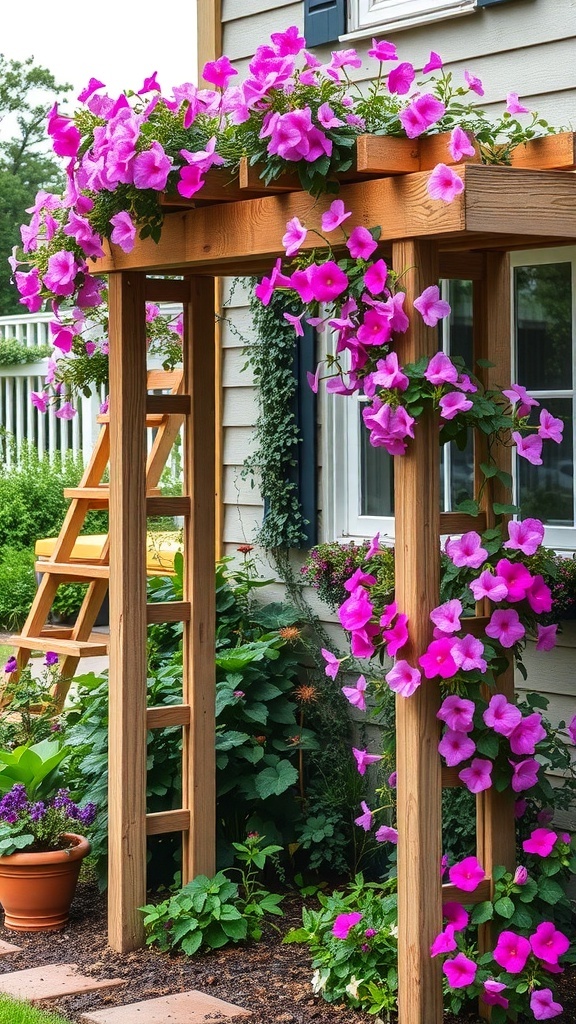
Vertical elements like trellises and arbors can really enhance a cottage flower garden. They add height and create a lovely focal point. In the image, you can see a beautiful wooden arbor adorned with vibrant pink flowers. This setup not only looks stunning but also invites climbing plants to flourish.
Using trellises and arbors is a great way to maximize space. They allow you to grow flowers and vines upward, making your garden feel more expansive. The bright blooms cascading over the structure create a charming, inviting atmosphere.
Consider placing a trellis near a seating area or pathway. This way, you can enjoy the beauty up close. The combination of flowers and wood adds a natural touch that complements the overall garden design.
Don’t forget about maintenance! Regular watering and pruning will keep your plants healthy and looking their best. With a little care, your vertical elements will continue to thrive and add character to your garden.
Choosing the Right Location for Your Cottage Flower Garden
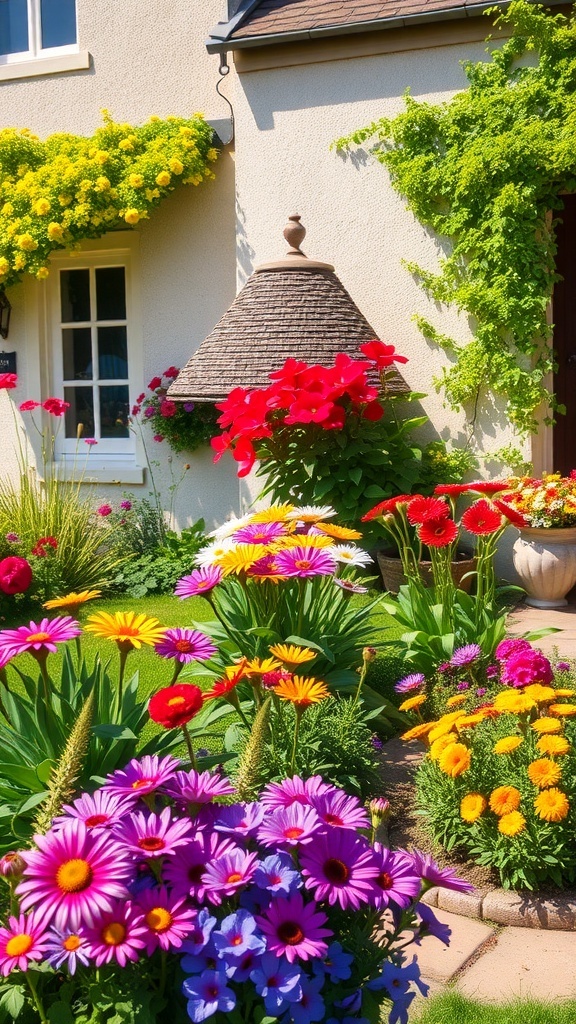
When planning your cottage flower garden, location is key. The image shows a vibrant garden filled with colorful blooms, showcasing how a well-placed garden can enhance the charm of a home. Look for spots that get plenty of sunlight, as most flowers thrive in bright conditions.
Consider the layout of your space. The garden in the picture has a lovely arrangement that draws the eye. Think about how you can create pathways or borders to guide visitors through your floral display. This not only adds beauty but also makes it easier to care for your plants.
Soil quality matters too. Check if your chosen spot has good drainage and rich soil. You might need to amend the soil to ensure your flowers flourish. The lush greenery in the image suggests a healthy environment, which is essential for a thriving garden.
Lastly, think about accessibility. You want to enjoy your garden without too much hassle. Position it where you can easily reach for maintenance, watering, and harvesting. A well-placed garden can be a delightful retreat, just like the one shown here.
Creating a Color Palette for Your Flower Garden
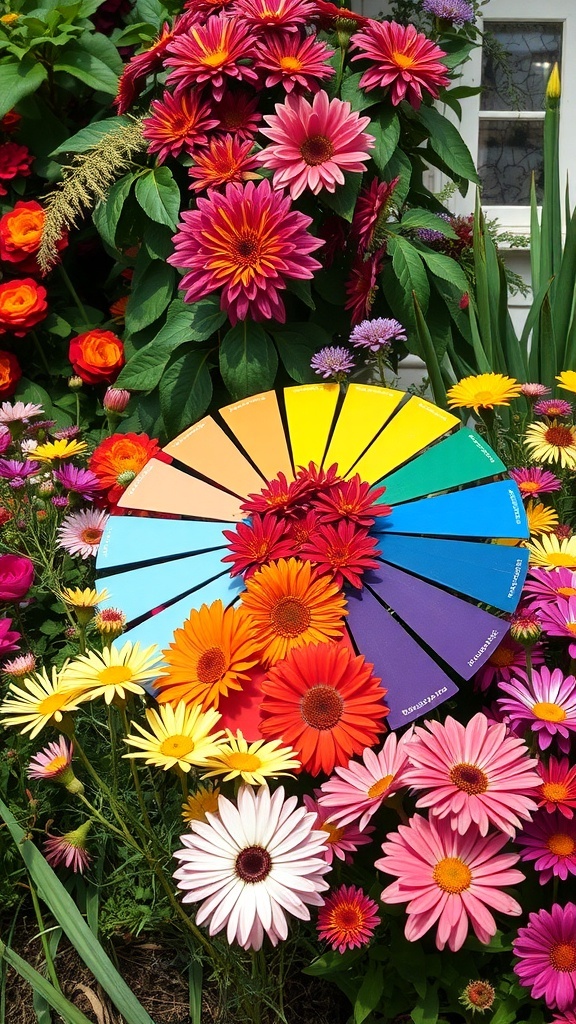
Choosing the right colors for your flower garden can make all the difference. The image shows a vibrant mix of flowers alongside a color palette. This visual representation helps in selecting hues that complement each other beautifully.
Start by considering the mood you want to create. Bright colors like yellows and pinks can energize the space, while softer pastels offer a calming effect. The flowers in the image, such as daisies and dahlias, showcase a lively combination that can inspire your choices.
Don’t forget about the seasons! Some colors shine in summer, while others may be more suitable for fall. Using the color palette as a guide, you can plan for blooms that will provide visual interest throughout the year.
Mixing different shades can create depth and texture. The palette in the image features a range of colors, from warm oranges to cool blues. This variety allows for creativity in your design, ensuring your garden feels dynamic and inviting.
Incorporating Edible Flowers into Your Design
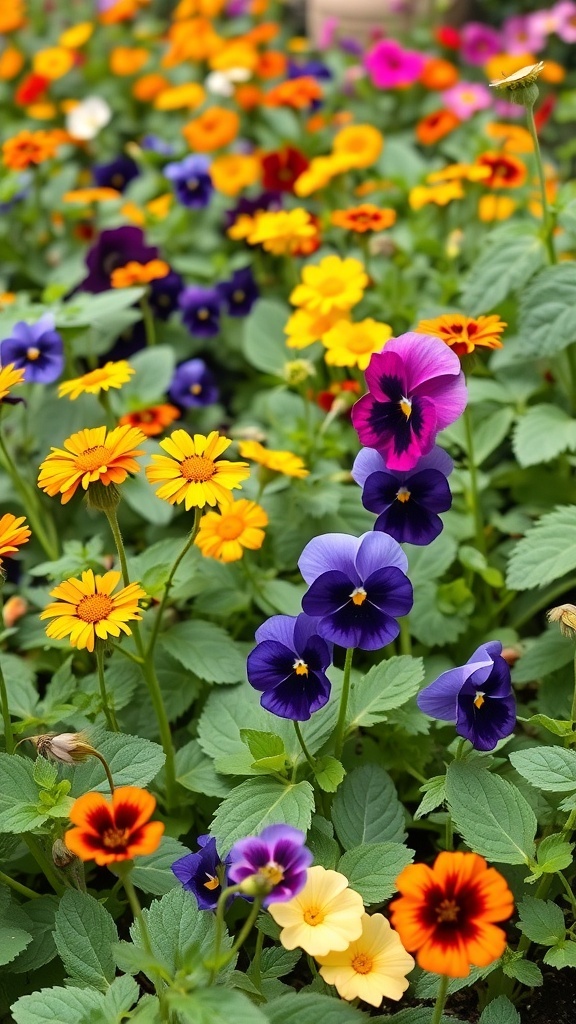
Creating a cottage flower garden is a delightful way to bring color and life to your outdoor space. One fun twist is to include edible flowers. These blooms not only look beautiful but can also add unique flavors to your meals.
Take a look at the vibrant mix of flowers in the image. You can see cheerful yellow and orange blooms alongside rich purple and pink petals. Flowers like pansies and marigolds are not just pretty; they can be used in salads or as garnishes. Imagine serving a salad topped with bright pansies, adding a pop of color and a hint of sweetness.
When planning your garden, think about the types of edible flowers you want to include. Calendula, nasturtiums, and violets are great choices. They thrive in sunny spots and can be easily integrated into your garden design. Plus, they attract pollinators, which is a bonus for your overall garden health.
Don’t forget to check that the flowers you choose are safe to eat. Always avoid using flowers treated with pesticides. Once you’ve picked your blooms, you can experiment with them in your cooking. Try adding them to ice cubes for a refreshing drink or using them to decorate cakes. The possibilities are endless!
Incorporating Perennials for Year-Round Beauty
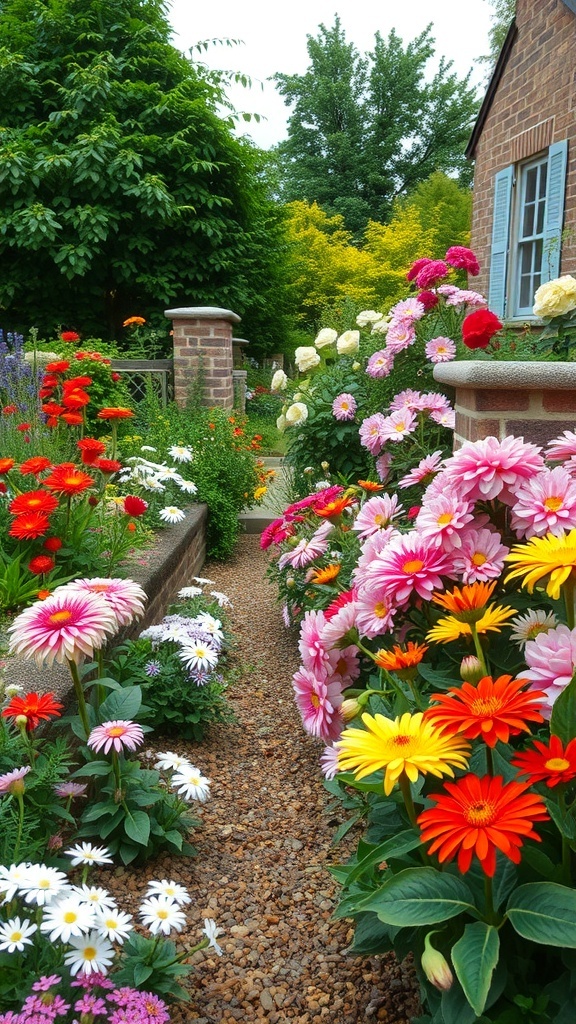
Creating a cottage flower garden is a delightful way to bring charm and color to your outdoor space. The image showcases a vibrant array of flowers lining a charming pathway, inviting you to explore the beauty of nature. With a mix of colors and textures, this garden design captures the essence of a cozy cottage atmosphere.
Perennials play a key role in maintaining beauty throughout the seasons. These plants return year after year, providing a reliable source of color and life. In the image, you can see a variety of perennials like daisies and gerbera daisies, which bloom in bright hues of pink, orange, and white. Their resilience makes them perfect for creating a low-maintenance garden.
When planning your garden, consider mixing different types of perennials to ensure continuous blooms. For instance, pairing early bloomers like daffodils with summer favorites such as coneflowers can create a stunning display. This not only keeps your garden lively but also attracts pollinators, adding to the garden’s ecosystem.
Don’t forget about foliage! Incorporating plants with interesting leaves can add depth and texture, even when flowers are not in bloom. The lush greenery in the background of the image complements the colorful flowers beautifully, creating a balanced and inviting space.
With careful selection and planning, your cottage flower garden can be a year-round delight. Embrace the beauty of perennials and enjoy the changing seasons in your own little paradise.
Utilizing Containers for Versatile Flower Arrangements
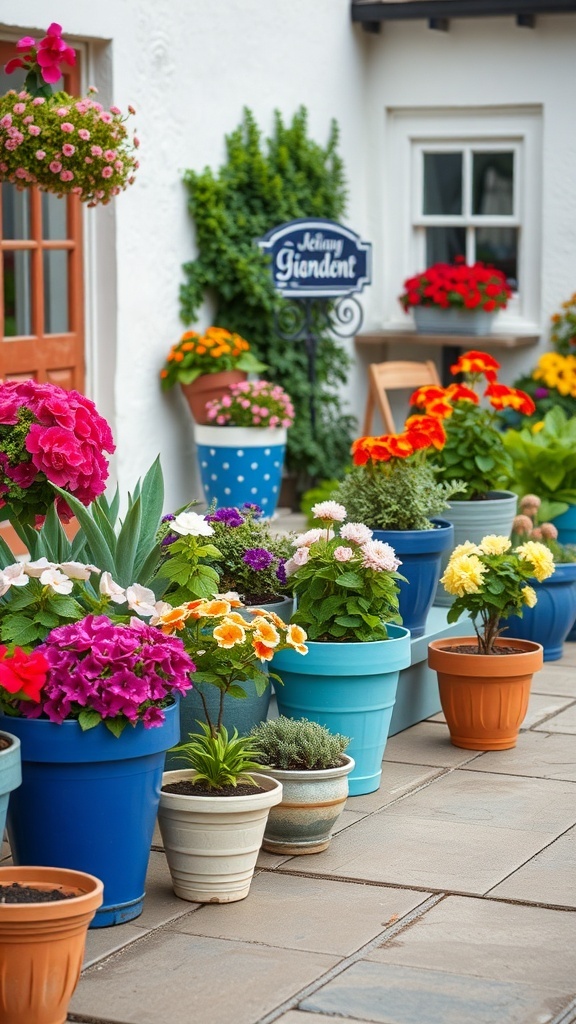
Container gardening is a fantastic way to add charm to your cottage flower garden. The image showcases a delightful array of colorful pots filled with vibrant blooms. Each pot brings its own personality, creating a lively scene that invites you to explore.
Using containers allows for flexibility in your garden design. You can easily move pots around to find the perfect spot for sunlight or shade. This adaptability means you can change the look of your garden with the seasons or your mood.
Mixing different sizes and colors of pots adds visual interest. Notice how the blue pots stand out against the white wall, while the hanging flowers bring a touch of whimsy. This playful approach makes your garden feel welcoming and unique.
Don’t forget about the types of flowers you choose! Combining perennials with annuals can create a dynamic display that lasts throughout the growing season. The image highlights a mix of petunias, daisies, and marigolds, all thriving together.
Lastly, consider adding herbs or small shrubs to your containers. They not only look great but can also be useful in the kitchen. With a little creativity, your container arrangements can become the stars of your garden.
Incorporating Garden Furniture for Relaxation
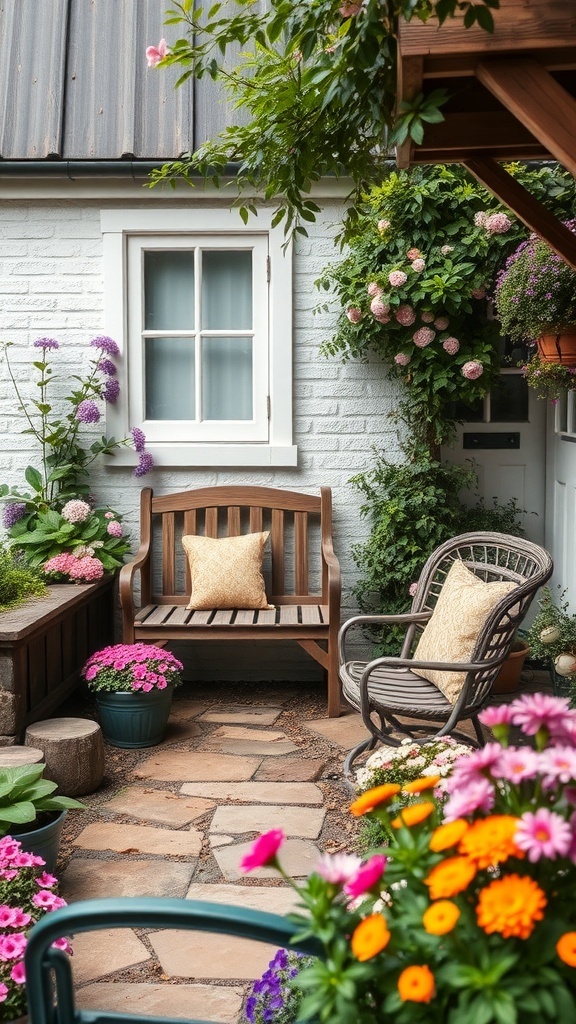
A cozy garden space can be a perfect retreat. The image shows a charming corner filled with vibrant flowers and inviting furniture. A wooden bench, paired with a stylish chair, creates a welcoming spot to unwind.
The flowers in various pots add color and life to the area. The stone pathway leads you right to the seating, making it easy to access. A soft cushion on the bench invites you to sit down and enjoy the surroundings.
Having comfortable furniture is key to creating a relaxing atmosphere. You can sip your morning coffee or read a book while surrounded by nature. The greenery and blooms provide a peaceful backdrop, enhancing your experience.
Consider adding a small table for snacks or drinks. This little touch can make your garden feel even more like a getaway. Whether it’s a sunny afternoon or a cool evening, this space is perfect for relaxation.
Seasonal Planting Strategies for Continuous Blooms
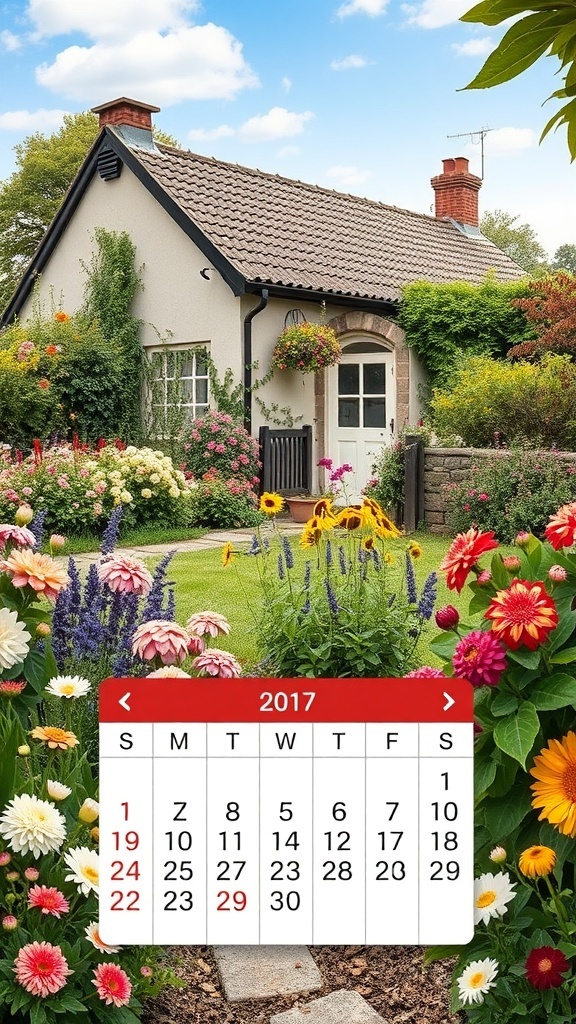
A cottage flower garden is a delightful sight, especially when it’s bursting with color throughout the seasons. The image showcases a charming home surrounded by vibrant blooms, creating a picturesque scene. To keep this beauty alive, seasonal planting strategies are key.
Start with spring. Plant early bloomers like daffodils and tulips. They bring life to your garden after winter. As these flowers fade, summer favorites like sunflowers and zinnias can take their place. This ensures your garden remains lively and colorful.
In the fall, consider planting asters and chrysanthemums. They thrive as temperatures drop and can last well into late autumn. Finally, winter can be a time for evergreens and ornamental grasses. They add structure and interest, even when other plants are dormant.
By planning your planting schedule, you can enjoy a continuous display of blooms. This approach not only enhances the beauty of your garden but also attracts beneficial pollinators all year round. A well-timed planting strategy makes your cottage flower garden a year-round delight.
Designing a Cottage Garden with a Rustic Theme
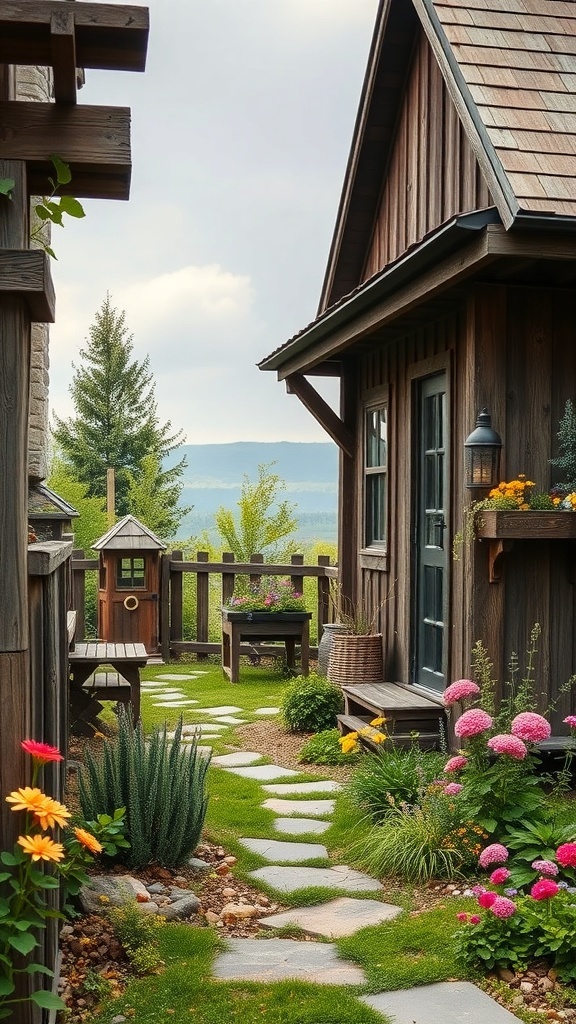
Creating a cottage garden with a rustic theme is all about embracing natural beauty and simplicity. The image shows a charming pathway leading through a flower-filled garden, surrounded by wooden structures that enhance the rustic feel. The use of natural stone for the path adds an earthy touch, inviting you to stroll through the blooms.
Bright flowers like daisies and pink hydrangeas bring color and life to the space. These plants not only attract pollinators but also create a welcoming atmosphere. The mix of greenery and flowers adds depth, making the garden feel lush and inviting.
Wooden elements, like the fence and the small shed, contribute to the overall rustic theme. They blend seamlessly with the natural surroundings, providing a cozy backdrop for the vibrant flowers. Incorporating furniture, like the wooden bench, allows for relaxation and enjoyment of the garden’s beauty.
Overall, this design captures the essence of a cottage garden, where nature and rustic charm come together harmoniously. It’s a perfect spot for anyone looking to unwind and enjoy the simple pleasures of gardening.
Creating Layers with Flower Heights
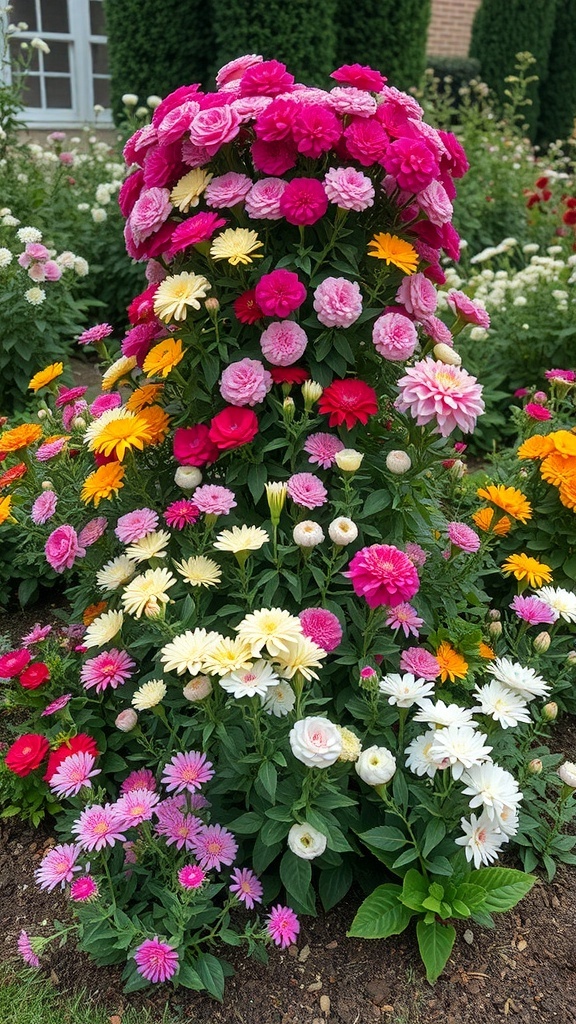
In a cottage flower garden, layering flowers by height adds depth and visual interest. The image shows a beautiful arrangement where taller blooms sit at the back, while shorter ones grace the front. This setup creates a stunning display that draws the eye.
The vibrant colors of the flowers, from pinks and whites to yellows and oranges, enhance this layered effect. The taller flowers, like the pink and red blooms at the top, provide a lovely backdrop for the shorter varieties below. This contrast makes each flower stand out.
When planning your garden, think about how different heights can work together. Mixing tall, medium, and short flowers can create a dynamic look. It’s a simple trick that can transform any garden space into a lively and inviting area.
Designing for Wildlife: Attracting Pollinators
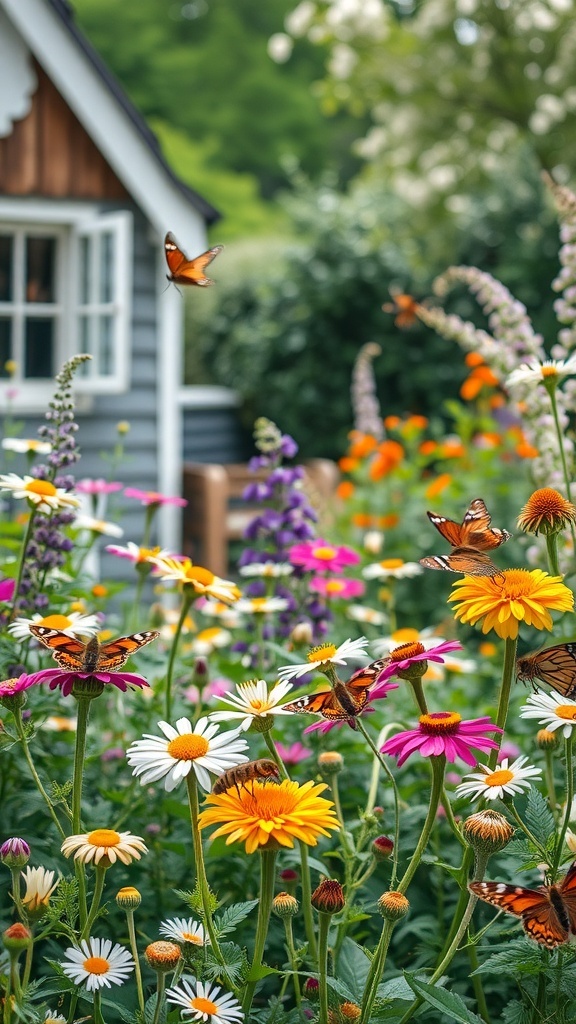
Creating a cottage flower garden is not just about beauty; it’s also about inviting nature into your space. The image shows a vibrant array of flowers, buzzing with life. Butterflies flutter among daisies, zinnias, and other blooms, showcasing the garden’s role as a haven for pollinators.
To attract these essential creatures, choose a mix of native plants. They thrive in your local environment and provide the nectar and pollen that butterflies and bees love. Flowers like coneflowers, asters, and sunflowers are not only stunning but also serve as food sources.
Consider planting in clusters. This makes it easier for pollinators to find their favorite flowers. A colorful patch of blooms will catch their attention and encourage them to visit. Avoid using pesticides, as they can harm these beneficial insects.
Adding a water source, like a shallow dish with pebbles, can also help. Pollinators need hydration, especially on warm days. With these simple steps, your cottage flower garden can become a lively spot for wildlife, enhancing both its charm and ecological value.
Integrating Foliage for Texture and Contrast
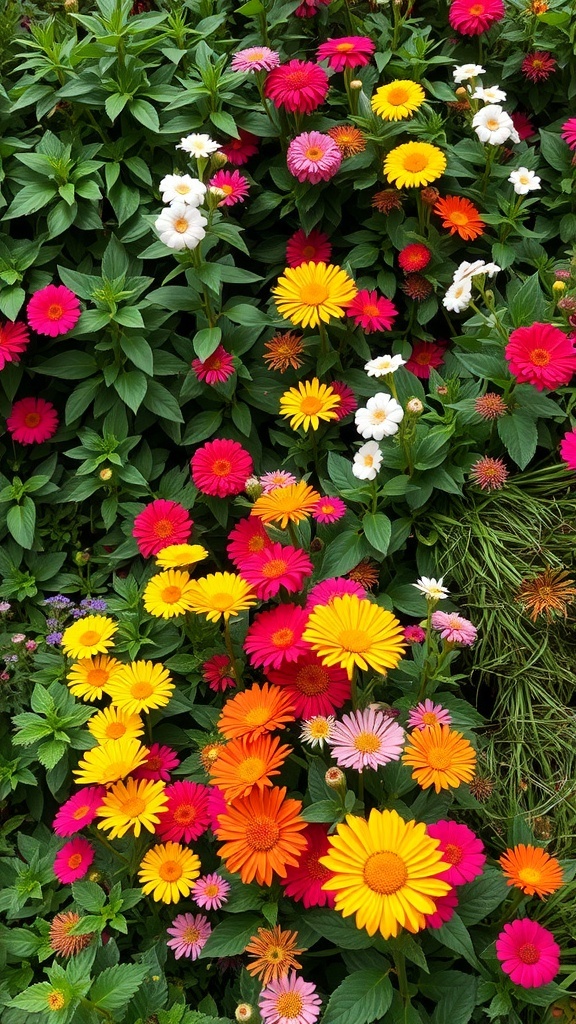
A cottage flower garden thrives on a mix of colors and textures. In this vibrant scene, you can see a delightful array of flowers, including cheerful yellows, pinks, and whites. The flowers are surrounded by lush green foliage, which plays a key role in enhancing the overall look.
Foliage adds depth and contrast to the bright blooms. The dark green leaves create a beautiful backdrop, making the flowers pop even more. This combination draws the eye and makes the garden feel alive and inviting.
When designing your own flower garden, think about how different types of leaves can complement your flowers. Varieties like ferns or hostas can add interesting shapes and textures. Mixing these elements will give your garden a more dynamic feel.
Don’t forget about seasonal changes! Different plants bring unique colors and textures throughout the year. This keeps your garden looking fresh and engaging, no matter the season.
Using Mulch and Ground Covers for Weed Control
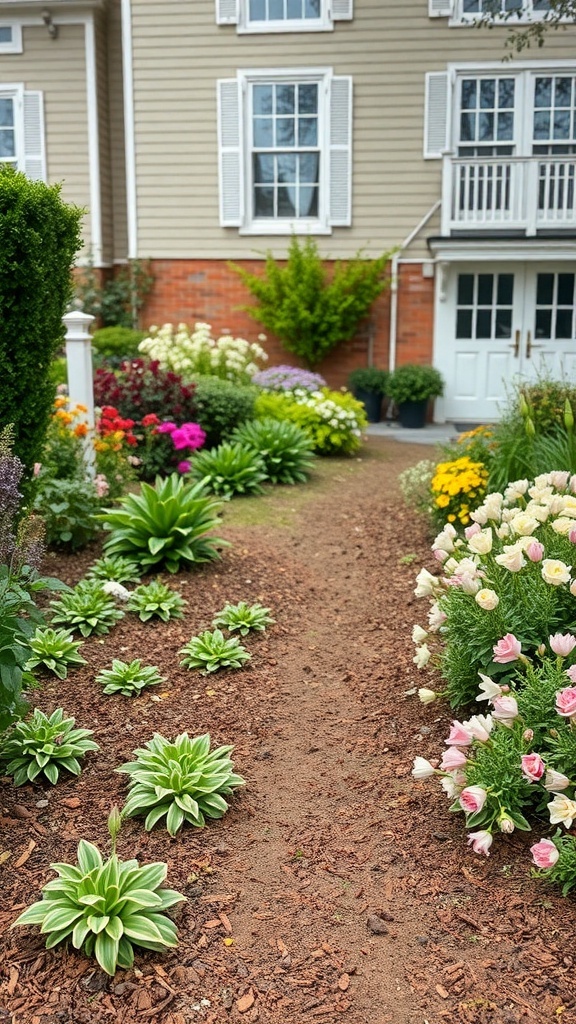
Creating a cottage flower garden is a delightful way to bring color and life to your outdoor space. One effective method to keep your garden looking its best is by using mulch and ground covers for weed control. In the image, you can see a beautifully arranged flower garden, with vibrant blooms and lush greenery lining a path. This setup not only looks inviting but also showcases the benefits of proper garden maintenance.
Mulch serves as a protective layer over the soil. It helps retain moisture, regulate soil temperature, and, most importantly, suppress weeds. In the image, the brown mulch contrasts nicely with the bright flowers, creating a neat and tidy appearance. Applying mulch around your plants can significantly reduce the time you spend weeding.
Ground covers are another fantastic option. They fill in gaps between plants, preventing weeds from taking hold. The hostas in the image are a great example of a ground cover that thrives in partial shade. They add texture and greenery while keeping the soil covered. Choosing the right ground cover can enhance your garden’s look while making maintenance easier.
Combining mulch with ground covers creates a beautiful and functional garden. Not only does it keep weeds at bay, but it also adds to the overall charm of your cottage flower garden. So, grab some mulch and consider planting ground covers to enjoy a vibrant and weed-free garden!
Creating a Focal Point with a Water Feature
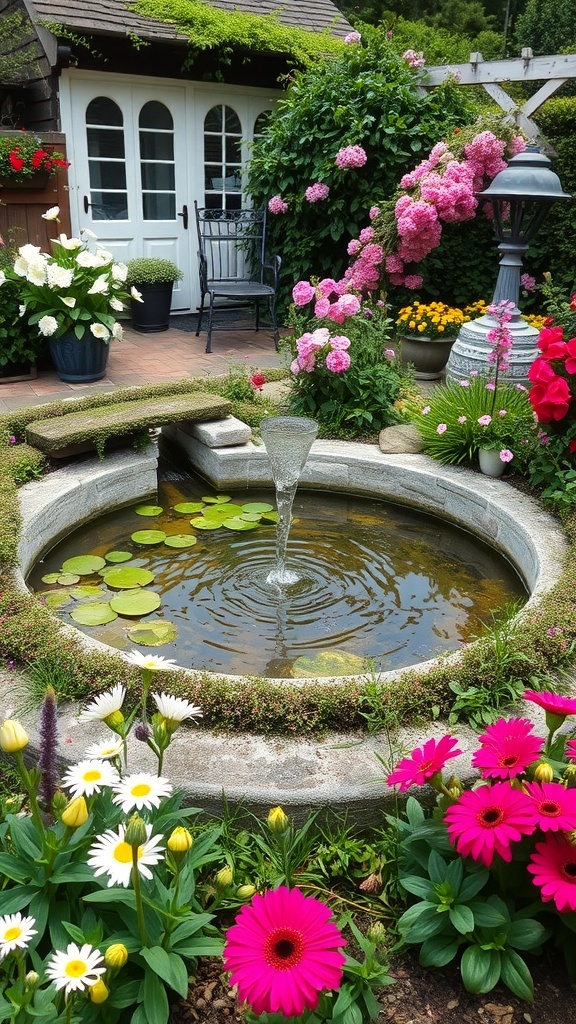
Adding a water feature to your cottage flower garden can create a stunning focal point. In the image, a charming fountain sits at the center, surrounded by vibrant flowers. The gentle sound of water adds a soothing element, making the garden feel more inviting.
The circular design of the fountain complements the lush greenery and colorful blooms. Notice how the pink flowers and white daisies frame the water, drawing the eye towards it. This arrangement not only enhances the beauty of the garden but also encourages wildlife, like birds and butterflies, to visit.
When planning your own garden, consider the size and style of the water feature. A small fountain can fit nicely in a cozy space, while a larger pond might serve as a grand centerpiece. Whichever you choose, ensure it harmonizes with the surrounding plants and flowers.
Incorporating a water feature can transform your garden into a peaceful retreat. It invites relaxation and offers a perfect spot for enjoying nature. So, whether you’re sipping tea or reading a book, the gentle splashes of water will enhance your experience in the garden.
Incorporating Garden Art and Decor
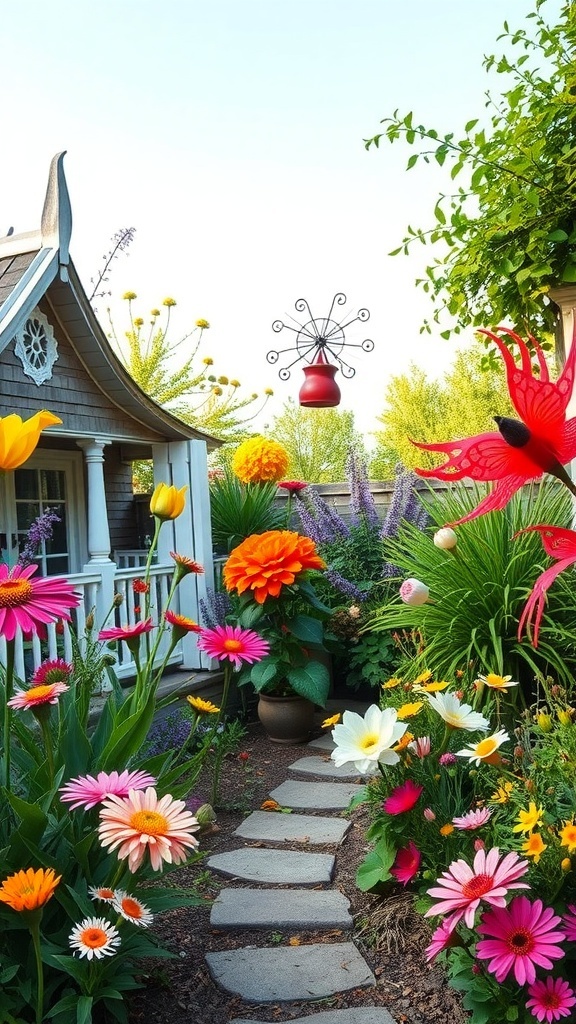
Creating a cottage flower garden is not just about the plants; it’s also about the little touches that bring your space to life. Garden art and decor can add personality and charm to your outdoor area. Think of it as the icing on the cake!
In the image, you can see a vibrant array of flowers lining a stone pathway. This colorful display draws the eye and invites you to explore. The whimsical decor, like the red lantern and playful sculptures, adds a fun element that enhances the overall look. These pieces can reflect your style and make your garden feel unique.
Consider adding items like garden stakes, birdhouses, or even a small fountain. These elements can create focal points and make your garden feel more inviting. Mixing different textures and colors can also add depth to your design. The key is to choose decor that complements your flowers without overwhelming them.
Don’t forget about functional art, too! A decorative bench or a charming trellis can provide both beauty and utility. This way, you can enjoy your garden not just as a visual feast but also as a cozy spot to relax and unwind.
Planning for Seasonal Changes and Maintenance
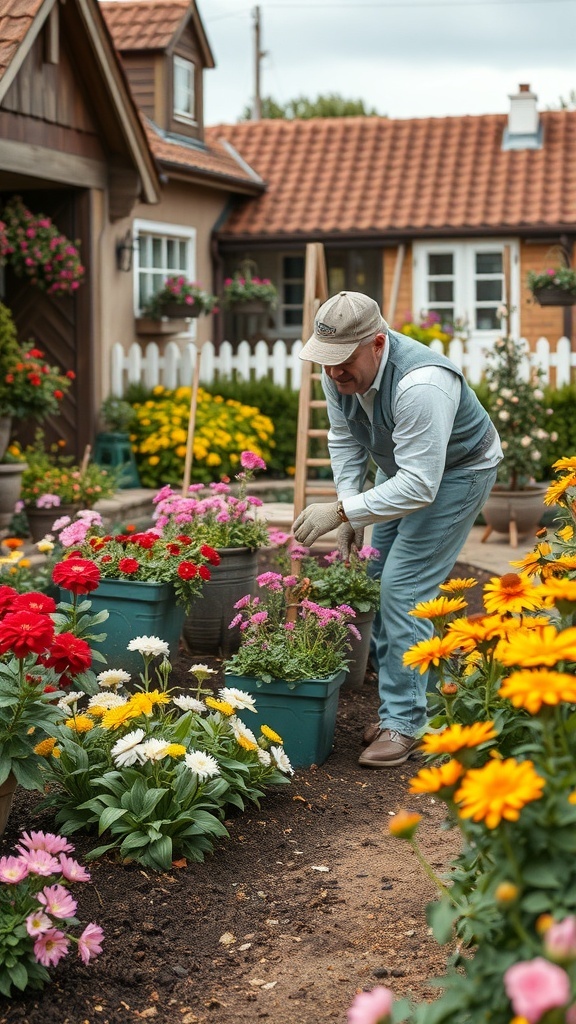
Creating a cottage flower garden is a delightful way to bring color and life to your outdoor space. The image shows a gardener tending to vibrant flowers in pots, surrounded by a charming cottage. This scene captures the essence of a well-maintained garden that thrives through the seasons.
Seasonal changes can greatly affect your garden’s appearance and health. It’s important to choose flowers that bloom at different times of the year. This way, you can enjoy a colorful display from spring through fall. Consider planting perennials that return each year, along with annuals for bursts of color.
Maintenance is key to keeping your garden looking its best. Regular watering, deadheading spent blooms, and checking for pests will help your flowers flourish. Mulching can also retain moisture and suppress weeds, making your gardening tasks easier.
As the seasons shift, be ready to adjust your care routine. In the fall, prepare your garden for winter by cutting back dead plants and covering the soil. In spring, you can start planting new flowers and refreshing the soil to encourage growth. With a little planning, your cottage flower garden can be a beautiful retreat all year round.
